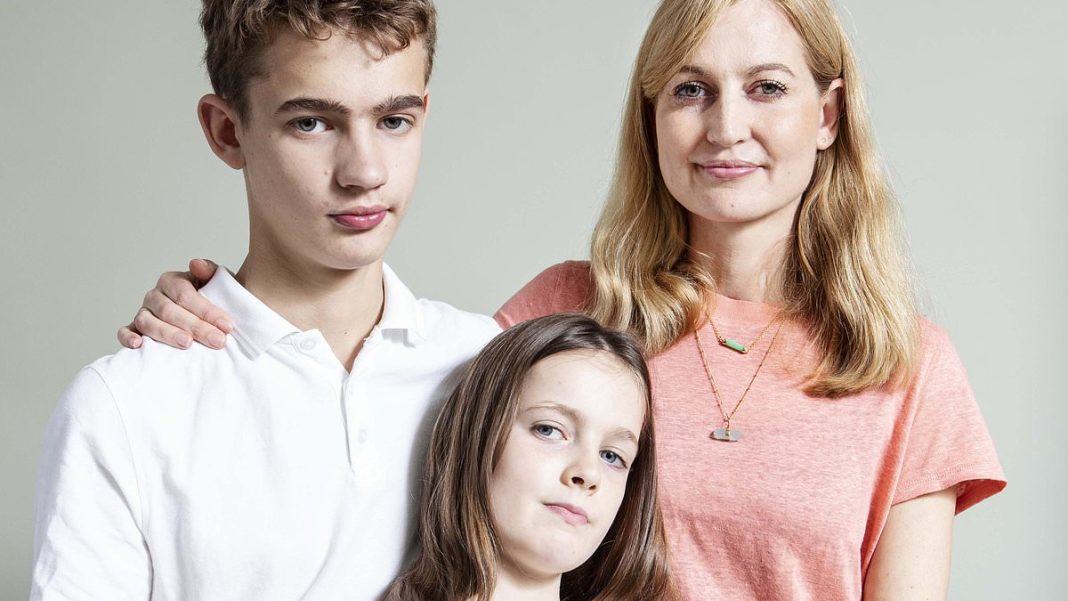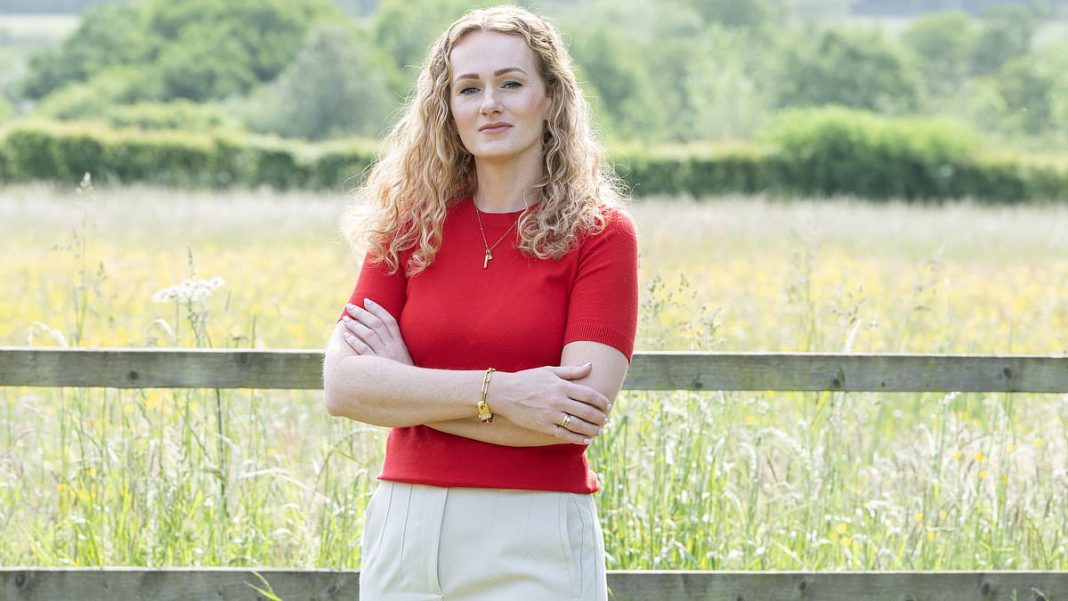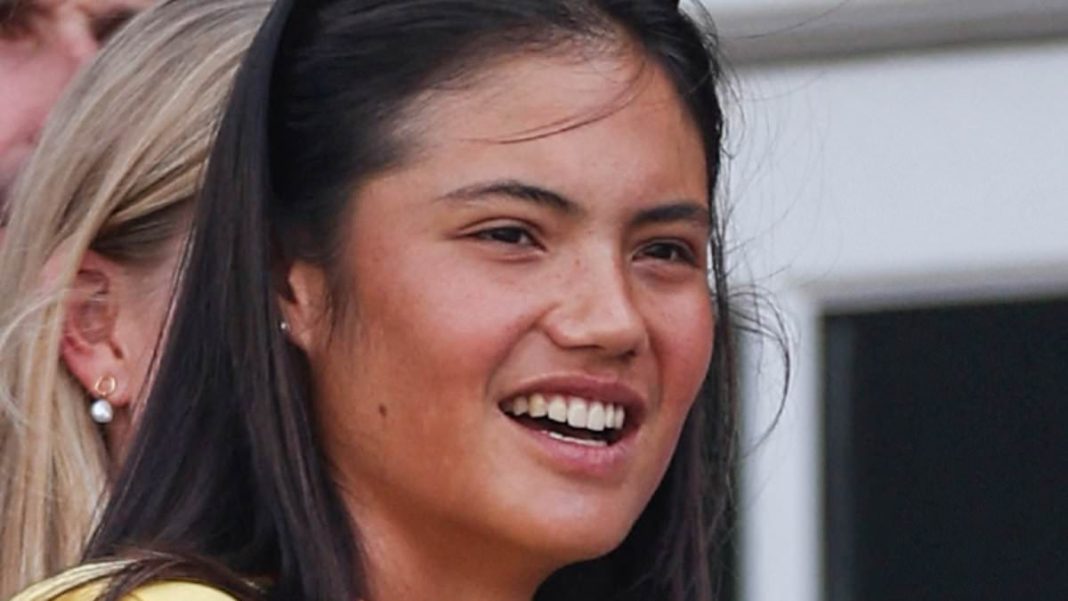Should wealthy people be allowed to buy their way on to drug trials? ,
It was a handwritten birthday party invitation that finally made Mel Dixon realise something was wrong.
Her firstborn son, Tom, then four, had struggled with feeding since birth. He’d screamed after having milk. He was clumsy. His speech lagged behind his peers. And he had a subtle but persistent tremor – a shakiness in his hands that was hard to explain.
But Mel reassured herself with what all first-time parents are told – that children develop at their own pace. By her own admission she’s clumsy herself, and anyway, every child has quirks.
‘Then this little boy in Tom’s school class gave him a card he’d written himself,’ she recalls.
‘It hit me like a ton of bricks. Tom didn’t even know what an “A” was. He couldn’t hold a pencil. He was about to start Reception and some of the other children were already writing letters and words.
‘That’s when I knew we weren’t just looking at a speech delay. Something deeper was going on.’
As Tom got older, several signs became more noticeable. His tremors and muscle twitches worsened. He also developed a squint and struggled to focus.
The gap between Tom’s academic and physical abilities and those of his peers grew wider. In Tom’s case, the full answer took 13 years to be revealed.
It came only after Mel, 46, and her husband Charlie, 47, an investment manager, pushed for whole-genome sequencing – mapping all his genes.
By this point Tom’s younger sister, Rosie, then seven, was showing similar signs and a year later, in 2021, the couple were told they both had the same mutation in a gene called DHDDS.
Fewer than 100 people in the world are known to have this gene mutation. It causes a neurodegenerative disease so rare no one knows much about how symptoms develop and if it shortens patients’ lives.
The symptoms include learning difficulties, a movement disorder akin to Parkinson’s disease (which includes tremors, muscle twitches, balance and co-ordination difficulties), cognitive decline and seizures.
The mutation is so rare the condition it causes doesn’t even have a name. There is no treatment.
Mel, who left her career in PR to raise the children, responded the only way she knew how. She set up a charity – Cure DHDDS – to raise money and connect with scientists worldwide.
I came across her family’s story through my work trying to fund clinical trials into rare conditions such as her children’s.
‘There are really tough days,’ says Mel, ‘but also moments of joy. They’re amazing kids.
‘I focus on understanding the science and speaking to researchers. That gives me hope.’
Finding a treatment would be amazing for the family. But it’s not just the Dixons who stand to benefit from more research.
The DHDDS gene is part of an important process in the body that helps build and move proteins and fats where they need to go. If this process goes wrong, proteins accumulate and cause damage in the brain, as they do in more common conditions such as Alzheimer’s, Parkinson’s, epilepsy and certain forms of autism.
So understanding ultra-rare conditions such as DHDDS might help unlock treatments for more common illnesses that affect vast numbers of people.
History is full of examples where studying a rare disorder has led to a breakthrough for something more widespread.
For example, studying familial hypercholesterolemia – a rare inherited condition that causes extremely high cholesterol levels – led to the development of statins, the most widely prescribed cholesterol-lowering drug.
This isn’t fringe science. It’s the sharp end of discovery. And that’s where our work comes in.
My colleague, the author and patient advocate Alexander Masters, and I have spent the last 13 years working – unpaid – to develop a new route for funding medical trials for ultra-rare conditions like Tom and Rosie’s.
In 2012, we raised £2million in just a few months to fund a clinical trial at Uppsala University, Sweden, into a potential treatment for neuroendocrine cancer – which starts in the cells that link the nervous system and hormones, and spreads to places such as the lungs or pancreas, sometimes without symptoms until it’s advanced.
The trial was inspired by Alexander’s friend, Dido Davies, who was dying from the disease.
Professor Magnus Essand at the university had a potential but untested treatment with no money to run a trial. Alexander asked if Dido could join the trial if he raised the money to fund it. They agreed.
Working with patients, families and the media, we ran a national campaign from our spare rooms.
Tragically, Dido died on the very day the funding target was hit.
But while we were raising the money another neuroendocrine patient, a US oil man, Vince Hamilton, contacted us and offered to pay around half of the £2million needed if he too could be on the trial. Vince also died before the trial started.
But it was this experience that got us thinking – can we create a system that ethically allows a rich patient to fund a trial in return for a place on that trial?
It would bring in new money – rather than competing for funds with traditional charities – and could be targeted at hard-to-fund rare disease research, which has little appeal for pharmaceutical companies: fewer patients equals less profit.
As Laurent Servais, a professor of paediatric neuromuscular diseases at Oxford University, explains: ‘Funding clinical trials in rare disease is increasingly difficult, considering the high costs and the low chances of a significant return on investment.’
This is the awful situation faced by the Dixons. There are treatments that might help, even cure, their children – but no money to fund the trials.
One potential treatment is ASOs (antisense oligonucleotides), tiny lab-made patches that work like plasters inside your cells.
They stick to the ‘instructions’ your DNA sends out to build proteins. These instructions sometimes have mistakes. ASO therapy doesn’t change your DNA, but it fixes the error in the message so the cell works correctly.
If they work for Tom and Rosie they could very well help many other individuals with single genetic disease-causing variants. The theoretical reach could be huge. But there’s no one to pay for the trials.
Our idea is to build an ethical framework for patients and researchers to come together – bypassing the usual bottlenecks. We call it Patient Powered Research. We are registered as a not-for-profit business and hope to convert it to a charity for new models of trial funding.
Our plan is to create what amounts to a ‘matching agency’, where we have a list of scientifically sound, peer-reviewed and yet currently unfunded trials and share that with potential patient donors who, if they, or their nominated patient, meet the inclusion criteria can pay for the trial in return for a place on it.
Cure DHDDS is a perfect example of the people we want to help.
With around £5million, a team at University College London could move forward with an early-stage but promising gene-therapy trial (of which there are very few) taking it from the lab to humans for the first time.
Meanwhile, the other option – the personalised ASO treatment already in early development in the US – could be made available to Tom and Rosie in the UK and offered to them as part of a trial at University College London. It is trials like this we hope to be able to fund.
Gene therapy, a pioneering technique that repairs or replaces faulty genes to treat the root cause of illness, though expensive (currently around £1.2 million per patient, though experts hope that cost will fall), could be a one-time treatment.
ASOs are different: they’re delivered regularly, every few months, via a lumbar puncture.
But the science is promising. Children with similar disorders have shown dramatic improvements – regaining speech, improving mobility or seeing seizures stop altogether.
Professor Paul Gissen, who is working on early trials at University College London, confirmed
that if a donor came forward to fund the work, a family like the Dixons would be considered (but there would be no special treatment and no direct contact with the researchers).
One of the challenges now is how to bring these complex, high-potential treatments to patients faster. That’s where Oxford University comes in.
As part of a transatlantic partnership with the Harrington Discovery Institute in the US, the Oxford-Harrington Rare Disease Centre, led by Professor Matthew Wood, is at the forefront of global efforts to accelerate therapies for conditions just like Tom and Rosie’s. The Centre is advancing close to 20 rare disease programmes, with the aim of bringing 40 new treatments into trials by 2034.
‘We see great potential – and indeed necessity – in the vision behind Patient Powered Research, enabling patients or their families to help fund early-stage trials,’ says Professor Wood.
It’s early days, but we are working with Professor Wood and colleagues on a potential partnership to finance a number of their trials. And it’s why we’re now looking for support to take Patient Powered Research to the next level – we need seed funding to build infrastructure, secure ethical and regulatory backing, and grow this into a sustainable platform for families like the Dixons across the UK and beyond.
As Mel says: ‘This isn’t just about our family. If we can make progress here, it could help countless others.’
Alexander and I have sometimes been accused of offering false hope to patients who, we’re told, should simply accept their fate. We reject that.
I’m a survivor of a rare cancer – neuroendocrine cancer, the same one Dido had and the reason Alexander and I joined forces.
I also have type 1 diabetes and know that as a result I have a drastically shortened life expectancy. And yet I pray for a cure.
Patients are perfectly capable of holding two thoughts in their minds at the same time: realism and hope.






